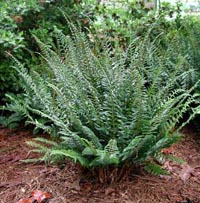Resource Library
Plant of the Week: Fern, Christmas
The University of Arkansas System Division of Agriculture does not promote, support or recommend plants featured in "Plant of the Week." Please consult your local Extension office for plants suitable for your region.
Plant of the Week
Christmas Fern
Latin: Polystichum acrostichoides

With Christmas fast approaching, it is time to consider the Christmas Fern (Polystichum acrostichoides). It’s one of the few green plants you are likely to see if you prowled the deciduous eastern forests during the last weeks of the year.
The association with Christmas is an old one, for the fronds were once harvested by the tons, baled into bundles and sold to florists for wreath making. We no longer rely on evergreen ferns for wreaths. Now we’ve got plastic!
The Christmas fern grows to about 18 inches tall and wide with all of the fronds emerging from a central crown. As the plant ages, it produces more fronds, but the usual number is about 20 on the typical plant. Given good growing conditions, plants produce many more fronds than you’ll see in the wild. The base of the frond and the central crown is covered with brown, scruffy scales.
The fronds are pinnately compound, meaning there is a central axis with the individual leaflets (pinnae in fern lingo), produced at right angles down its length. The pinnae are to 2 inches long, but get proportionally smaller as you move down the midrib. Typical pinnae have a thumb-like lobe at the top, giving it a mitten-like appearance. Some see a Christmas stocking in outline, but they are wrong. It’s a mitten.
About two-thirds of the way down the length of the frond, the pinnae get abruptly smaller. These are the spore-bearing pinnae that, on the under surface, have two rows of spore dots down their length. Under magnification these sori – the name used by fern experts – produce a number of curled, snail-like cases.
While Christmas ferns are evergreen, their fronds are not immortal. In early spring, just as new fronds begin to uncurl, the old fronds wither away.
According to one reference - the only one of several I consulted - the name Christmas fern was given to the plant by John Robinson of Salem, Mass. Though no date is given, this probably occurred during the height of the Victorian era, about 1880. Ferns in general were popular during that period and Christmas decorations took on new importance. So, the use of a readily available natural resource for Christmas wreath making and as filler in cut flower arrangements seems like a logical combination.
But as with all such natural collecting schemes, over collecting destroyed lots of plants. By the 1930s, one author reported it was becoming harder to find in the wild. But, the craze seems to have passed, and the Christmas fern still is one of the most commonly seen and recognizable wild ferns in the eastern woodlands.
Christmas ferns grow on shaded, north or east-facing slopes in humus-rich soil. Though they require good drainage, these tough ferns are often found on raised hummocks in swampy areas. It seems indifferent to soil pH, but like most ferns, is usually found in acidic sites.
In the garden it makes an excellent groundcover for deep shade. Performance is much better if the soil is lavishly amended with organic matter. If you prefer, the natural look you see in the wild, any old soil seems to work just fine. They’ll not grow in sunny locations. I’ve never seen a pest problem on the plant.
Propagation is by spores, but I’ve yet to successfully raise them by this means. Thus far, my efforts have involved using fronds collected in mid-winter, which did not work. I believe that most of the spores were already released from the sori when I planted the pots, so nothing was achieved from the project.
At my feet as I write this is a fresh supply of fern fronds, all harvested in October. Hopefully, with a better supply of spores, my success rate will improve. Even if it doesn’t work, it’s still fun to try.
By: Gerald Klingaman, retired
Extension Horticulturist - Ornamentals
Extension News - December 17, 2004
The University of Arkansas System Division of Agriculture does not maintain lists of retail outlets where these plants can be purchased. Please check your local nursery or other retail outlets to ask about the availability of these plants for your growing area.